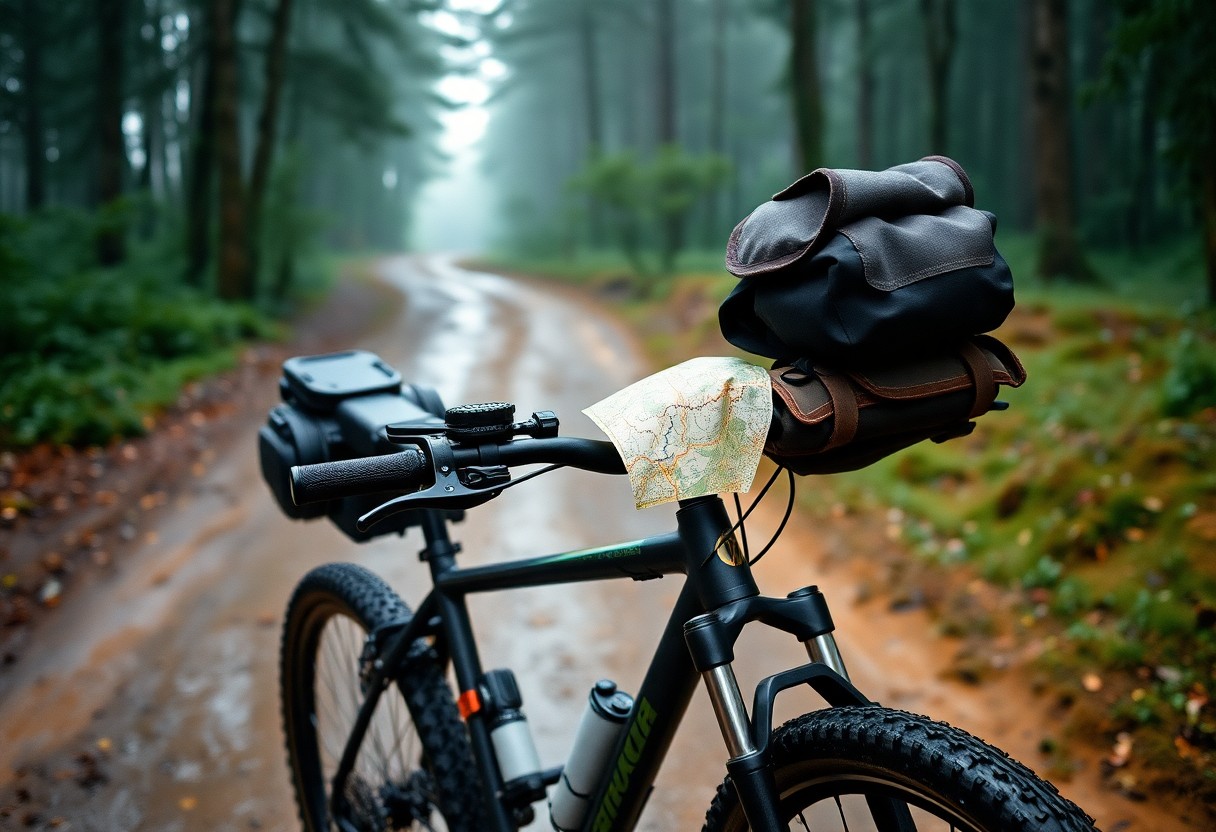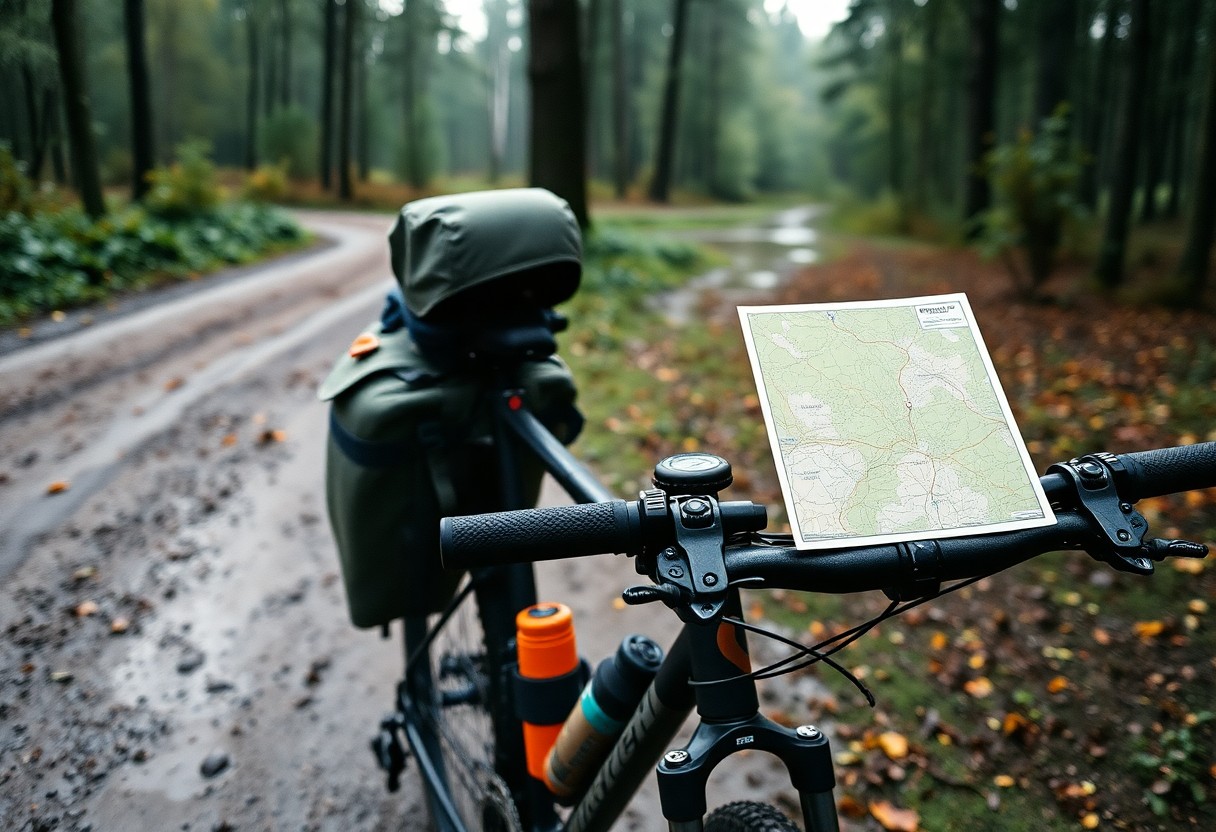Many bikepackers face the challenge of tackling wet weather during their adventures, which can drastically affect your experience. When planning for rain and muddy conditions, assessing what gear is worth the extra weight becomes vital. You need to ensure you have the importants that protect you from the elements and keep you comfortable, while also considering the balance between durability and pack size. By understanding what is truly necessary, you can enjoy your ride without being bogged down by unnecessary items.
Wet Weather Gear: What You Can’t Afford Not to Pack
Preparation for wet weather is non-negotiable; the right gear can make or break your bikepacking adventure. Carrying items like a waterproof jacket, durable panniers, and a quality groundsheet will protect you from the elements and ensure your equipment remains dry. Investing in lightweight, compact items, while also considering durability and effectiveness, is necessary for maintaining your comfort and safety on the trail.
Essential Clothing to Stay Dry and Comfortable
Your choice of clothing plays a significant role in your comfort during wet rides. Opt for a high-quality waterproof jacket with breathable fabric to regulate temperature while keeping you dry. Pair it with moisture-wicking base layers and waterproof trousers to ensure you can manoeuvre comfortably and avoid chills from dampness. Don’t overlook your head; a waterproof hat and good gloves will further protect you from the elements.
High-Performance Equipment: Balancing Weight and Functionality
Carefully selecting high-performance gear is vital for a successful wet weather expedition. Lightweight materials that offer exceptional water resistance, such as ripstop nylon and Gore-Tex, can significantly reduce your load while keeping you protected against rain. Look for gear designed with advanced technology to provide maximum breathability and insulation without the bulk, allowing for better mobility and comfort during those relentless wet spells.
Products like ultra-lightweight waterproof bivvy bags or compact tarps can weigh scarcely a few hundred grams, ensuring your setup remains manageable. Many brands also offer multi-functional items, such as jackets that convert into vests or insulated liners that can be used independently. This versatility optimises your packing efficiency. Always check for user reviews and expert recommendations to find high-performance gear with proven reliability in the wettest conditions, striking the ideal balance between weight and functionality.
Choosing the Right Bike: Rain-Ready Attributes
In wet weather bikepacking, selecting a bike equipped with rain-ready attributes can significantly enhance your experience. A sturdy frame with weather-resistant materials, along with fenders to protect you from muck and puddles, will keep you comfortable and dry. Look for bikes featuring sealed bearings to prevent rain damage and a geometry that promotes stability on slippery surfaces. Such features reduce the chance of mishaps and improve your grip and control, allowing you to focus on the adventure ahead.
Features that Enhance Stability in Slippery Conditions
A bike designed for stability in slippery conditions is crucial for your safety. Characteristics such as a longer wheelbase can improve handling, while a lower centre of gravity enhances balance. When navigating through wet terrains, wide handlebars provide additional control, allowing you to manoeuvre effectively over obstacles. Furthermore, incorporating disc brakes ensures reliable stopping power, even in the rain, reducing the risk of skidding.
How Tyre Selection Impacts Wet Weather Riding
Choosing the right tyres is one of the most significant decisions for wet weather riding. Tyres with a deeper tread pattern offer better grip on slick surfaces, allowing for improved traction. Specifically, a tyre width of around 32mm to 40mm can provide more surface area, enhancing stability while rolling over puddles and mud. Additionally, look for a rubber compound that stays flexible in low temperatures, as firmer compounds can become slippery when cold and wet.
For instance, tyres with more pronounced siping—that is, small grooves in the tread—can channel water away and maintain contact with the ground better than those without. A mixed tread pattern featuring both knobbies and slick areas can cater to various terrains, allowing flexibility in handling different surfaces. Investing in quality, high-visibility tyres can also enhance safety by ensuring you’re seen in gloomy weather. Ultimately, the right choice can drastically change how confidently you navigate through challenges on your journey.

Route Planning: Navigating Rainy Terrain
Your journey through wet weather demands careful route planning, as terrain can shift dramatically under damp conditions. Puddles and mud can make certain trails impassable, while others may reveal hidden hazards. Use hard-packed surfaces or trails that are known for good drainage to your advantage. Additionally, having alternate routes in mind can prevent delays or setbacks, ensuring you stay on your schedule even if the skies are grey.
Identifying Safe and Scenic Wet Weather Paths
While the rain can dampen some paths, many routes transform into stunning reflections of nature’s beauty. Seek trails that are less prone to flooding and are well-drained to keep your journey safe. Forests might offer a sheltered respite from heavy downpours, while coastal routes could provide dramatic scenery. Consult trail reviews or local forums for insights on conditions others have faced recently.
The Role of Weather Forecasts in Trip Preparation
Before you head out, checking reliable weather forecasts is imperative for a successful bikepacking trip. Understanding potential rainfall amounts and temperatures will aid in your decision-making for gear selection, as well as influence your daily riding schedule. Adverse weather conditions can lead to challenging environments, making accurate forecasts instrumental in keeping you safe and comfortable.
Having access to up-to-date weather apps or services allows you to monitor changing conditions in real-time, which can be especially helpful during lengthy trips. Certain apps provide specific data on precipitation amounts, wind speeds, and even changes in temperature throughout the day. A sudden storm may necessitate a shift in your itinerary, such as taking shelter or delaying your departure. By staying informed, you can anticipate challenges and adjust your plans accordingly, making for a smoother ride through whatever nature throws your way.
Maintaining Momentum: Nutrition and Safety in the Rain
Rain can sap your energy and make sustaining your momentum a real challenge. Ensuring you consume adequate nutrition and hydration is vital for maintaining performance and safety during your journey. Keeping your body fuelled and hydrated can significantly impact your stamina and reaction times, enabling you to tackle any adverse conditions with confidence. Carrying the right supplies and managing your intake will help you stay energised and in control, preventing fatigue and enhancing your resilience against the elements.
Hydration Strategies for Rainy Conditions
Even when it’s pouring, staying hydrated should remain a priority. Humidity levels often peak in wet weather, making it easy to overlook the need for water. Aim to drink regularly throughout the day, focusing on lighter fluids that your stomach can easily digest while riding. Electrolyte drinks and hydration tablets can be particularly beneficial, replacing crucial salts lost through sweat, helping to maintain performance as you navigate slippery terrain.
Staying Fueled: Best Snacks for Adverse Weather
Selecting the right snacks is key to keeping your energy levels stable during rainy bikepacking adventures. Opt for high-calorie, moisture-resistant options, such as energy bars, nut butter packets, and dried fruit. These compact choices pack a punch in nutrition without adding excessive weight to your load, vital when the elements feel against you. Avoid overly sugary snacks that might lead to energy crashes, and target a balance of carbohydrates, proteins, and fats for sustained energy throughout your ride.
Some of the best snacks for adverse weather include trail mix with nuts and seeds, which provides a mix of healthy fats and protein along with energy-dense carbohydrates. Low-moisture energy bars are great as they typically resist sogginess, ensuring they remain palatable and effective fuel on the go. Fruit leathers not only taste good but offer natural sugars for a quick energy boost. By selecting snacks that endure the elements, you’ll keep your body nourished and ready to tackle any challenges the rain throws your way.
Community and The Shared Experience of Wet Weather Bikepacking
Engaging with fellow bikepackers in the rain fosters a sense of community that’s hard to replicate. While the rain may pose challenges, it simultaneously creates bonds through shared stories of overcoming adversity. You’ll find warmth in collective experiences, with everyone coming together to navigate the elements, exchanging laughter and encouragement as you tackle the weather together.
Learning from Seasoned Bikepackers: Shared Tips and Tricks
Seeking advice from seasoned bikepackers can be immensely beneficial in wet conditions. They often share valuable insights that have been honed over countless soggy adventures, such as:
- Choosing the right waterproof gear
- Tips for effective navigation in low visibility
- Strategies for maximising warmth and comfort
Perceiving their approach to challenging situations can enhance your own bikepacking journey, equipping you with practical techniques to manage the elements.
The Joy of Weathering the Storm: Building Camaraderie on the Trail
Finding joy amidst the rain transforms the bikepacking experience into something memorable. Battling the elements with fellow adventurers fosters deep connections, as shared struggles often lead to shared triumphs. Each downpour becomes an adventure story, worth recounting around a campfire as you sip warm drinks. The collective spirit shines brightest when you all come together to face the uncertainties of the journey, signalling not just resilience but a shared passion for exploration.
As you navigate through the rain, there’s a sense of unity that emerges among fellow bikepackers. Laughter and camaraderie thrive, even in the most adverse conditions. The satisfaction of pushing through the storm creates memories that bind you to your companions; every soaked sock and slippery trail is a badge of honour. The stories you share become the fabric of your community, reinforcing bonds formed in the midst of trials, turning gloomy rides into treasured tales that last a lifetime.
To wrap up
Ultimately, your wet weather bikepacking adventure depends on striking the right balance between comfort and weight. Invest in quality waterproof gear, proper tyres, and reliable protection for your importants, ensuring you can enjoy the ride despite the rain. Prioritise items that enhance your experience and keep you safe, allowing you to focus on the journey, rather than the challenges posed by the weather. By thoughtfully selecting what you take with you, you’ll find that an enjoyable and rewarding bikepacking experience is fully achievable, even in the wettest conditions.
